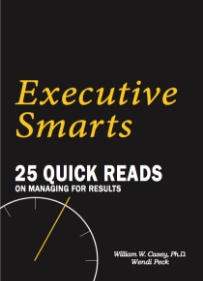For a PDF of this article, click here.
Any serious strategist must ask, “How will we know when we’ve succeeded?” Strategies have intended outcomes – goals – and it’s terribly helpful if those outcomes are clear enough that success or failure will be indisputable.
So, we’re offering an alternative to the usual questions such as: “Do we have metrics?” (Or worse, “Do we have enough metrics?”) Instead, lead with, “Is our success stated so clearly that we could place a bet on it?”
The Bar Bet
At some point most of us have been in good-natured arguments with friends that amounted to not much more than redundant bickering. Such as:
You (beer in hand): “Yeah, I’ve seen that guy play. He’s a natural-born athlete. He’s going to have a great first year.”
Friend: “I doubt it. He might have natural talent, but he hasn’t developed it yet. I predict a ragged first year for that guy.”
You: “No way! He’s going to surprise everyone. That guy is good.”
Friend: “You’re crazy.”
. . . and then something magical happens, something wonderful, something that halts the bickering and then transforms conversation . . .
One of you says, “I’ll bet you twenty dollars that you’re wrong.”
This is the kind of comment that, as some academics would say, provokes an “epistemological shift.” Now, you both must work together to agree on objective and verifiable proof of success – a definition of “a great first year.”
If you have ever been through this kind of bar chatter, then you know exactly how to have “the right metrics.” It’s all about crafting a description of success that is so clear, you and a friendly skeptic could bet on it. It’s that simple.
Non-bet-able vs. Bet-able
Some typically vague (non-bet-able) strategic goals, and some bet-able alternatives:
| You couldn’t bet on (or against) these |
But you could bet on (or against) these |
| We’re going to build a culture of safety. | We’re going to reduce worker days lost due to injuries on or off the job by at least 50%. |
| Become more energy conscious. | Achieve at least a 20% month-to-month reduction in kilowatt hours per square meter of building space over previous 12 months. |
| Raise public awareness of our organization. | In this calendar year, there will be at least 10 articles that mention our name in the Wall Street Journal and/or the New York Times. |
Go Ahead and Argue
Notice that you might not agree with all our bet-able alternatives. That’s a good thing. It means the proposed definition of success is so clear that we can argue over it before we start spending time and money to achieve it!
Next time you make a grand declaration of direction (say, “We’re going to be an employer of choice!” or, “We’re going to provide humanitarian assistance,” or “I’m going to start being a better parent,”) ask yourself how you would define success if someone bet twenty dollars against you. If your declaration passes the “bar bet” test, then you’re good to go. The people paying for the result will know what they’re getting; the people doing the work will have clear direction; and you will have the satisfaction of knowing – without question – whether you’re successful.
Learning "What Works"
Related point. There are many ways to learn "what works." (A favorite of ours is "be a Borg, like Genghis Kahn.") Economist Tim Harford's recent TED talk touts the importance of getting at “what works” through humility, trial, and error (or “trial and correction,” as one friend calls it). The only thing left out of Harford's powerful talk is the importance of defining “what works.” The bar bet helps you do exactly that.
Published: July 21, 2015


Pingback: To Innovate Don’t Mistake Symbols for Reality - Lakewood, CO, Washington, DC , and Around the Globe | Executive Leadership Group, Inc.
WendiP
Gary, we’re glad you liked it! And we certainly agree with your assessment that fuzzy goals produce wasted effort. That’s the upshot of determining what you’re going to DO before determining — indisputably — what you’re going to ACHIEVE. Also, we’d agree that many folks like fuzzy goals because it helps them dodge accountability. We’ve met plenty of folks like that through the years. Though, in our experience, a larger portion of leaders just don’t think to take that first simple (but hard) step of defining outcomes so well that you could place a wager on them.
Gary Santorella
Thanks Bill & Wendi!
Liked your article a lot. Putting goals and objectives in simple, measurable terms is the difference between being effective (or not) in any undertaking. Not to do, as you suggest, inadvertently injects waste into any system (in the form of unfocused effort). I find that in many situations, when managers choose not to define parameters, what they really are attempting to do is to avoid being measured (i.e. held responsible/accountable).
Merc
Some would say you are stating the obvious……..but only after reading this blog! The genius of this posting is its simplicity. At the same time, it adds clarity and focus to a concept that is absolutely essential for successful strategic planning, and most important, strategic execution. Love the concept and the slide.
Merc
Bill
Thanks VERY much, Merc. We worked hard — and over several years — to come up with a way to express this idea simply, but not simplistically. (I think the idea might finally have struck us over a beer. Hmm. Don’t remember.)
John Dodson
Thank you. This really opened a door of thought and came in to play for me today.
Keep up the great work.
John
Tim McGuiness
Good job. I’ll bet you didn’t know that your post would make me laugh three times, make me think of 5 clients, a dozen prospects and the chances of the Bengals winning the Super Bowl. Either way, I’ll buy you the beer.
WendiP
You’re right! You would have won that bet. And we’ll take you up on that beer! (Good luck on the Bengals. Don’t bet too much.)
Bob Batson
Wendy and Bill,
This is an amusing application of Game Theory. You would probably enjoy
A Beautiful Math – John Nash, Game Theory, and the Modern Quest for a Code of Nature, by Tom Siegfried.
Bill
Bob, thanks! We had thought of it more as empiricism with wet elbows, but we LOVE the connection with game theory. And, look forward to reading the book. Thanks for the reference!
Vance Hall
I liked this one. Bar bet is nice analogy.
Leif Smith
I bet you don’t write three more this good within three months. But I can’t possibly clarify that unless we are at a bar.